Plato’s theory of Ideas constitutes a gigantic effort to establish the mystic doctrine upon an intellectual basis. The relation of created things to the ‘pattern laid up in heaven’ is, as we saw, that methexis, or participation, which Aristotle equated with mimesis, the ‘imitation’ by which the living world was built upon the Pythagorean numbers. Thus the relationship created by earliest man, (…) the vehicle of the first-known religion, is now made articulate. The wheel has come full-circle. (Rachel Levy, Gate of Horn, 1948).1
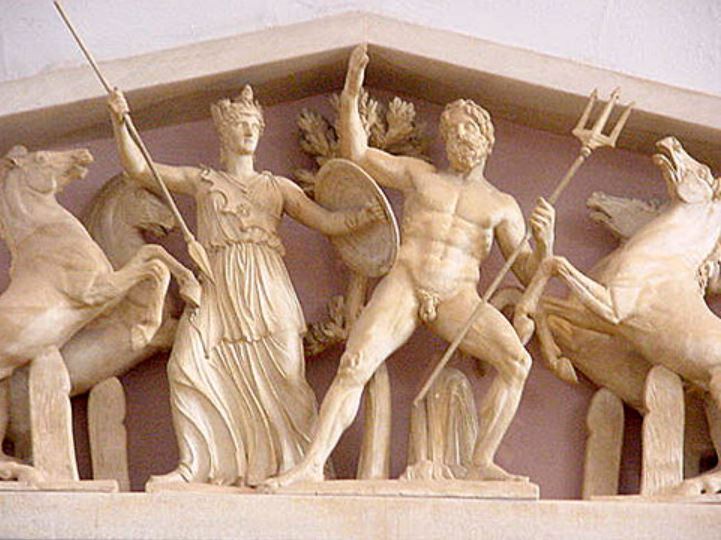
Athena and Poseidon on the Parthenon 432 BC.2
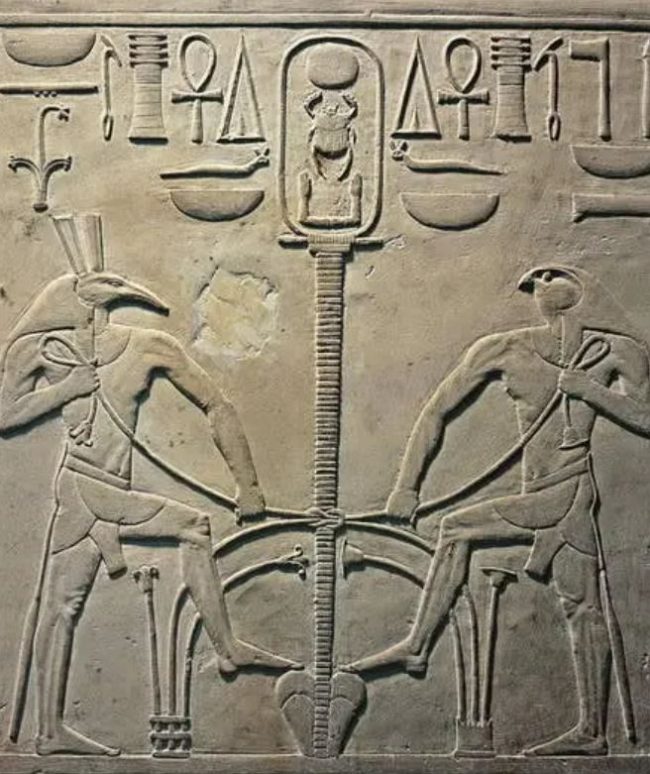
Seth and Horus binding upper and lower Egypt together, c1950 BC — 1500 years before classical Athens.3
*
The excellent Theoi Project site has a selection of texts describing the contest of Athena and Poseidon over which of the two would name Athens and be its paramount god. With some modifications and additions, notably the oldest passage from Herodotus,4 and the revealing use of Athena and Poseidon as geographical and economic markers by Plutarch, these are:
Herodotus, Histories, 8.55 (c425 BC)
In that acropolis is a shrine of Erechtheus (…) and in the shrine are an olive tree and a pool of salt water. The story among the Athenians is that they were set there by Poseidon and Athena as tokens when they contended for the land. It happened that the olive tree was burnt by the barbarians with the rest of the sacred precinct, but on the day after its burning, when the Athenians ordered by the king to sacrifice went up to the sacred precinct, they saw a shoot of about a cubit’s length sprung from the stump.
Plato, Menexenus 237c (c390 BC):
Our country [Athens] is deserving of praise, not only from us but from all men, on many grounds, but first and foremost because she is god-beloved. The strife of the gods who contended over her [i.e. Athena and Poseidon] and their judgement [through the Olympians] testify to the truth of our statement.
Callimachus, Hecale Fragment 1.2 (3rd century BC)
The land [Attika] which she [Athena] had newly obtained by vote of Zeus and the other immortals and the witness of the Snake [Kekrops]5.
Ovid, Metamorphoses 6.70 ff (1st century BC – 1st century AD):
The rock of Mavors [= Mars = Ares] in Cecrops’ citadel is [in] Pallas [Athena’s] picture [in her weaving contest with Arakhne] and [there is also shown] that old dispute about the name of Athens. Twelve great gods, Jove [Zeus] in their midst, sit there on lofty thrones, grave and august, each pictured with his own familiar features: Jove in regal grace, the Sea-God [Poseidon] standing, striking the rough rock with his tall trident, and the wounded rock gushing sea-brine, his proof to clinch his claim. [In the picture, Athena] herself she gives a shield, she gives a spear sharp-tipped, she gives a helmet for her head; the aegis guards her breast, and from the earth struck by her spear, she shows an olive tree, springing pale-green with berries on the boughs; the gods admire; and Victoria [Nike] ends the work.
Statius, Thebaid, VII: 185 (1st century AD)
Minerva banished Neptune’s fount from her citadel
Plutarch, Parallel Lives: Themistocles (1st-2nd century AD)
Themistocles equipped the Piraeus, because he had noticed the favorable shape of its harbors, and wished to attach the whole city to the sea; thus in a certain manner counteracting the policies of the ancient Athenian kings. For they, as it is said, in their efforts to draw the citizens away from the sea and accustom them to live not by navigation but by agriculture, disseminated the story about Athena, how when Poseidon was contending with her for possession of the country, she displayed the sacred olive-tree of the Acropolis to the judges, and so won the day.
Plutarch. Morals: Quaestiones Convivales (1st-2nd century AD)
For you [Hylas] are wont to recount unto us how he [Neptune] has been oftentimes overcome — here [in Athens] by Minerva, in Delphi by Apollo, in Argos by Juno, in Aegina by Jupiter, in Naxos by Bacchus — and yet has borne himself always mild and gentle in all his repulses. In proof whereof, there is even in this city a temple common to him and Minerva, in which there is also an altar dedicated to Oblivion. Then Hylas (…) replied: You have omitted, Menephylus, that we have abolished the second day of September, not in regard of the moon [to coordinate the solar and lunar calendars], but because it was thought to be the day on which Neptune and Minerva contended for the seigniory of Attica.
Apollodorus, Bibliotheca 3.14.1 (2nd century AD):
Kekrops, a son of the soil, with a body compounded of man and serpent, was the first king of Attika (…) In his time, they say, the gods resolved to take possession of cities in which each of them should receive his own peculiar worship. So Poseidon was the first that came to Attika, and with a blow of his trident on the middle of the acropolis, he produced a sea6 which they now call Erekhtheis7. After him came Athena, and, having called on Kekrops to witness her act of taking possession, she planted an olive tree, which is still shown in the Pandrosion.8 But when the two strove for possession of the country, Zeus parted them and appointed arbiters, not, as some have affirmed, Kekrops and Kranaus, nor yet Erysikhthon,9 but the twelve gods (Δωδεκάθεοι). And in accordance with their verdict the country was adjudged to Athena, because Kekrops bore witness that she had been the first to plant the olive. Athena, therefore, called the city Athens after herself, and Poseidon in hot anger flooded the Thriasian plain and laid Attika under the sea10.
Pausanias, Description of Greece 1.24.2 (2nd century AD):
[On the Akropolis is a] group [of statues] dedicated by Alkamenes.11 Athena is represented displaying the olive plant, and Poseidon the wave.
Pausanias, Description of Greece 1.24.5:
As you enter the temple that they name the Parthenon, all the sculptures you see on (…) the rear pediment represent the contest for the land between Athena and Poseidon.
Pausanias, Description of Greece 1.27.1:
About the olive tree they have nothing to say except that it was testimony the goddess produced when she contended for their land. Legend also says that when the Persians set fire to Athens the olive tree was consumed, but on the very day it was burnt it grew again to the height of two cubits.
Hyginus, Fabulae 164 (2nd century AD):
When there was a contest between Neptunus [Poseidon] and Minerva [Athena] as to who should be the first to found a town in the Attic land, they took Jove [Zeus] as judge. Minerva won because she first planted the olive in that land, said to be there to this day. But Neptunus, in anger, wanted to have the sea flood that land. Mercurius [Hermes], at Jove’s command, forbade his doing that. And so Minerva in her own name founded Athens, a town said to be the first established in the world.
The ultimate result12 of the contest between Athena and Poseidon over Athens, and of the interest taken in it by the Olympian gods in council, was that Athena and Poseidon came to be worshipped in the same temple on the acropolis, the Erechtheion. It was here that Athena’s primary cult statue was housed, an ancient figure carved from olive wood, which seems to have been saved from her original temple when it was destroyed by the Persians in 480 BC. The chief priestess of Athena was stationed at the Erechtheion to serve at the altar where civic sacrifices to the goddess were made. Furthermore, this temple of the two together was where the great procession on the last day13 of the Panathenia festival terminated — not at the later-named Parthenon. So the intense contest between these two of the 12 chief Greek gods led14 to a reconciliation brought about by the intervention of the other 10 of the Olympians led by Zeus.
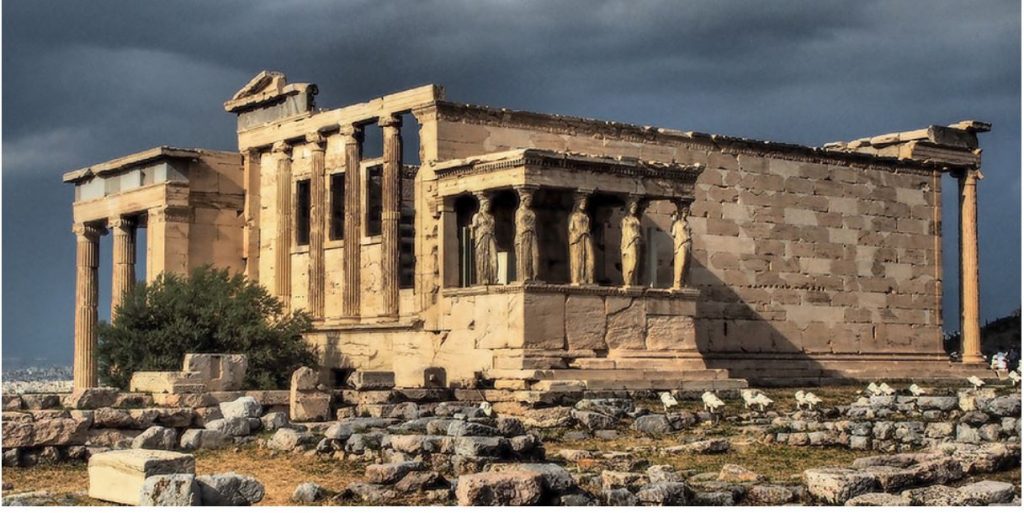
The Erechtheum on the acropolis with Athena’s olive tree, 406 BC.
Hegel called Greece the heir of Egypt and there are many parallels between this contest of Athena and Poseidon with the millennia earlier Egyptian contestings of Horus and Seth.15
In the mythology of ancient Egypt, Horus the hawk god and Seth, the desert animal god, fought each other in mortal combat over the lordship of the land. Horus was usually taken to be the god of lower Egypt to the north, Seth of upper Egypt to the south (although there seem to have been ancient cult sites to each of them in both areas). Their reconciliation brought about by a council of the nine great gods was the mythological founding event of the combined Egyptian nation.
Seth was the god of the arid desert as opposed to Horus of the fertile fields of the Nile valley and delta. Similarly in Greece, Poseidon was the god of desiccating salt water as opposed to Athena of the fresh water dependent olive tree.16 Athena was awarded Athens on the basis of this difference, but Athens, like Egypt, required both. Egypt obtained products from the desert, especially stone and metals, and required its vast peripheral extent as protection for its center. Above all, it was it was from the southern desert that the Nile brought water and life to the Egyptians. Athens, too, required many products from the salt water sea, especially food and trade, and relied on it for protection (as demonstrated particularly at Salamis).
In Greece the story of the contesting of Athena and Poseidon was told not only of Athens but also of Troizen in the Argolid, where the Athenians fled during the Persian sack of their city.17 And similar stories were told (with Athena being substituted by other protagonists) of Hera and Poseidon in Argos (where Poseidon caused the fresh water rivers to dry up and the land to be flooded with salt water from the sea),18 Helios and Poseidon in Corinth,19 Zeus and Poseidon in Aegina, Apollo and Poseidon in Delphi, and Dionysus and Poseidon in Naxos.20 Even in far inland Sparta, Pausanias reports (3.17.3) that the largest figures on the temple of Athena along with Athena herself were Poseidon and his consort, Amphitrite.21
Finally, the great Greek epics of the Iliad and the Odyssey were tales set against the background of the fateful enmity between Athena and Poseidon — and of their reconciliation.
Troy was Poseidon’s city and Athena working with Hera enabled its destruction. Euripides’ Trojan Women sets all this out in its opening monolog:
Poseidon: From the depths of salt Aegean floods I, Poseidon, have come (,,,) for since the day that Phoebus and I with exact measurement set towers of stone about this land of Troy and ringed it round, never from my heart has passed away a kindly feeling for my Phrygian town, which now is smouldering and overthrown, a prey to Argive might. For, from his home beneath Parnassus, Phocian Epeus, aided by the craft of Pallas, framed a horse22 to bear within its womb an armed army, and sent it within the battlements, a deadly statue; (…) Vanquished by Hera, Argive goddess, and by Athena, who helped to ruin Phrygia, I am leaving Ilium, that famous town, and my altars; (…) Farewell, O city once prosperous! farewell, you ramparts of polished stone! if Pallas, daughter of Zeus, had not decreed your ruin, you would be standing firmly still.
Poseidon’s revenge, now working with Athena who has turned against the Greeks for their desecrations of the altars and rites of the gods, was to delay the homecoming of Odysseus and to destroy all his men. Here is the exchange of Athena and Poseidon that continues on from Poseidon’s monolog in Euripides’ play:
Athena: May I address the mighty god whom the gods revere and who to my own father is very near in blood, laying aside our former enmity?
Poseidon: You may; for over the soul the ties of kin23 exert no feeble spell, great queen Athena.
Athena: For your forgiving mood my thanks! I have messages to impart affecting both yourself and me, lord. (…) I will impose on [the Greeks] a return that is no return.
Poseidon: While they stay on shore, or as they cross the salt sea?
Athena: When they have set sail from Ilium for their homes. On them will Zeus also send his rain and fearful hail, and inky tempests from the sky; and he promises to grant me his thunder-bolts to hurl on the Achaeans and fire their ships. And you, for your part, make the Aegean strait to roar with mighty billows and whirlpools, and fill Euboea‘s hollow bay with corpses, that Achaeans may learn henceforth to reverence my temples and regard all other deities.
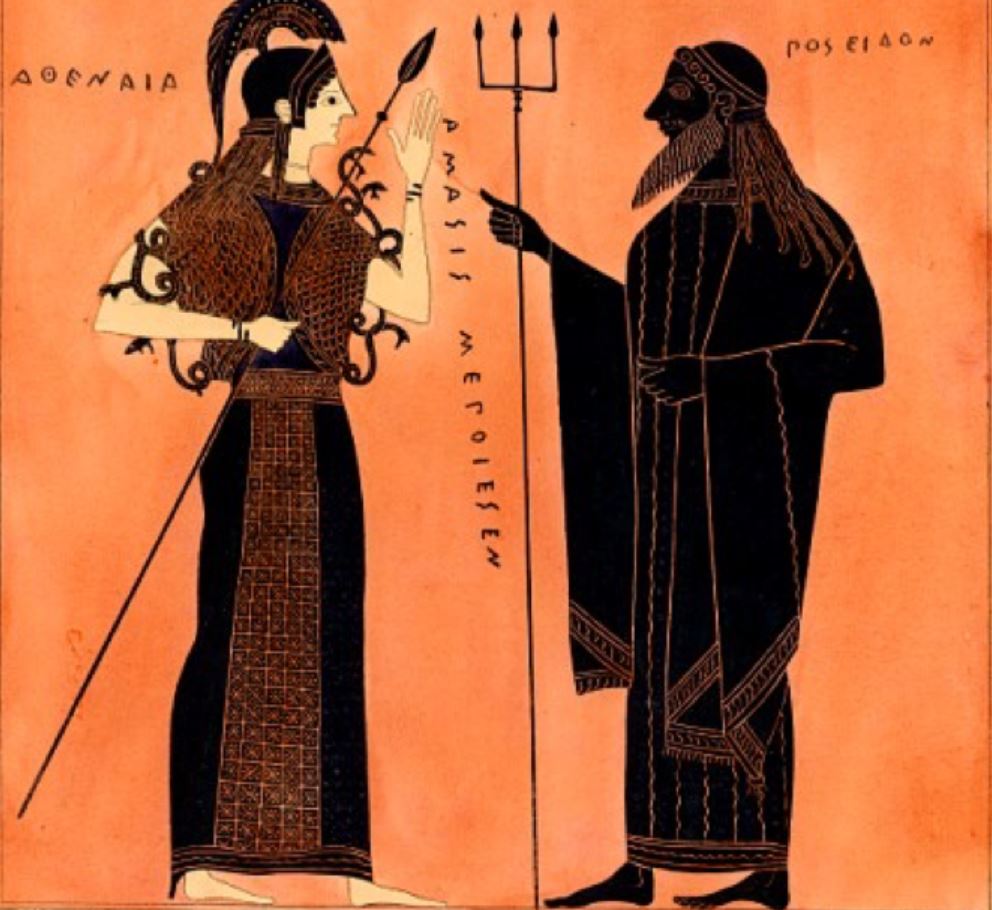 Athena and Poseidon, c 530 BC.24
Athena and Poseidon, c 530 BC.24
All this matched Egypt where stories of Seth’s struggles not only with Horus but also with Osiris and other gods were already proverbial from the time of its earliest records — two millennia before classical Athens. There, too, Seth was seen as ultimately losing conflict after conflict, though with intermittent triumphs in them, before becoming25 reconciled with Horus, integrated into the community of the gods (with an important place in the boat of the sun god’s daily journey) and worshiped by the Egyptians.
The contests of Horus-Seth and of Athena-Poseidon were both settled by councils of the gods, councils which represented the triumph of justice both in their balanced assembly and in their rulings.
Both cases are examples of the threefold of Being as seen also in Plato’s γιγαντομαχία περὶ τῆς οὐσίας with its (1) gods, (2) giants and (3) philosophical child ‘begging for both’.26 All these conflicts involve divine beings who are rival ontologies that are equally epistemologies. Being itself is knowledgeable in fundamentally different ways (as polytheisms have always insisted), although it is much more than this as well of course — the inertial power of manifestation, for example.
Horus (1) versus Seth (2) is a fundamentally different matter from Horus and Seth together (3), just as Athena (1) versus Poseidon (2) is a fundamentally different matter from Athena and Poseidon together (3) — and just as Plato’s gods (1) versus the giants (2) is a fundamentally different matter from ‘both together’ as perceived by the philosophical child (3).27 In parallel fashion in Egypt, the peace between Horus and Seth was often said to have been mediated by Thoth (3), the philosophical Ibis god who invented letters.28 Difference within the plurality of Being is necessarily also a belonging together ‘there’ and the very archetype of peace.29 Otherwise, as seen in gnosticisms and heresies of all sorts, opposition that is merely antagonistic inevitably leads to a demand for singularity and, ultimately, to the denial of any sort of plurality at all.
The central question at stake in all these contestings concerns two twofolds: that of either-or (Athena or Poseidon, Horus or Seth, gods or giants) and that of both-together (Athena and Poseidon, Horus and Seth, gods and giants). The former dynamic implicates a demand for unilateral hegemony and singularity; the latter, a recourse to reconciliation and harmonious plurality.
The fundamentality of the plurality option to the Egyptians and Greeks is shown in the accounts of the reconciliation of Horus and Seth, and of Athena and Poseidon, by its institution through — and as a reflection of! — the assembly of the nine great gods of Egypt and of the twelve Olympians in Greece. The γιγαντομαχία portrays the same archetype of reconciled divine contesting.
The great difficulty to this third position is that it cannot be taken as singular truth or reality without reducing it to the would-be monolithic structures of the first and second. The third can be the third only by embracing that first and second to which it is fundamentally opposed. But fundamental difference of course characterizes the relation of every possibility of Being to every other possibility in its astonishing plurality of fundaments. The inescapable fate of human being lies just here — to be exposed to the fundamental differences of powers far greater than it.
Another marker of the central difference between the warring and the reconciled twofolds was that the Athenians omitted the day from the calendar on which the antagonistic contest between Poseidon and Athena was said to have taken place.30 The action of antagonistic contest was, so to say, denied time and space — perhaps this is what was behind the altar dedicated to Oblivion? — in favor of a calendrical round grounded in mutual recognition. Here is Plutarch (Morals: De fraterno amore, 11):
But let them observe with caution that day above all others, as it may be to them the beginning either of mortal enmity or of friendship and concord.31
- Cited by McLuhan in ‘Maritain on Art’ and in ‘Wyndham Lewis: His Theory of Art and Communication’ (both 1953). ↩
- This is a reconstruction of the west pediment of the Parthenon showing the contest of Athena and Poseidon. The olive tree of Athena is in the background between the gods. Is this a sign of Athena’s victory over Poseidon? Or is it a sign of their reconciliation in the worship of both gods in the Erechtheum on the acropolis? For the olive tree, like all trees, is planted in the ground but reaches to the heavens — a representation of the peace of earth and sky and of the possibility of the reconciliation of all things. ↩
- Relief now in the Egyptian Museum, Cairo. The plants below Seth (papyrus) and Horus (lotus), which they are using to tie the knot between them, symbolize upper and lower Egypt respectively. The royal cartouche above them, of the pharaoh Senusret I (1971-1926 BC) reads Kheperkare, ‘the Ka of Re is created’ = the spirit of the sun god arises at dawn. The relief therefore shows the combined kingdom of Egypt as the mirroring product of divine manifestation. The c1950 date is the date for the relief, not for the contestings of Horus and Seth which are much older — doubtless stretching into prehistory. Special note should be made of the third power between Horus and Seth, an axis, like the olive tree between Athena and Poseidon, which combines the two (whether of gods or regions) without reducing them to undifferentiated singularity. Great questions are gathered here, especially regarding time, since the third is not related to the conciliated two as their consequential result, but as contemporaneous with them. See notes 12 and 30. ↩
- The Wikipedia entry for the ‘Erechtheion‘ notes that there are passages in Homer referencing the home of Athena in the Erechtheion in the form of her ancient olive wood statue. But the references given there (Iliad VII 80–81 and Odyssey II 546–551) seem to be reversed and should be Iliad II 546–551 and Odyssey VII 80–81. ↩
- For Kekrops-Cecrops see the passage from Apollodorus’ Bibliotheca above and note 9 below. ↩
- The salt water well of Poseidon in the Erechtheum was called a ‘sea’ (θάλασσα). ↩
- For the connection of ‘Erekhtheis’ with Poseidon, see ‘Erysikhthon’ below. ↩
- The Πανδρόσειον was a quadrangle just west of the Erechtheum dedicated to one of the daughters of Kekrops, Πάνδροσος. The olive tree of Athena growing here served to tie a kind of knot in which Kekrops and his sons served as kings of Athens under the aegis of Athena, but Athena herself was identified with the daughter of Kekrops, Pandrosos. ↩
- Kekrops, Kranaus and Erysikhthon were the mythical early kings of Athens. Their rites and saga were closely bound to that of Athena and Poseidon for Athens issued from them in the same way as it did from the contest and reconciliation of the two Olympians. Kekrops was half man and half serpent and both the city of Athens and Kekrops’ sons were the manifestation of the fertility of the resolution of the conflict between the two species he embodied. The line of the kings represented continuing order, while its descent from the snake represented the celebrated Athenian autochthony or ‘earthborn ancestry’. All this again reflected Egypt since Seth was often portrayed as a snake and it was his reconciliation with the ‘higher’ power of the hawk god, Horus, that was the founding event of the nation. The resulting civilization owed everything to the periodically replenished soil of the Nile valley and delta. ‘Erysikhthon’ = ‘Earthshaker’ was named after Poseidon, the god of earthquakes. ↩
- See note 6. ↩
- Alkamenes — the great Greek sculptor a generation before Plato. ↩
- Phrases like ‘the ultimate result’ place the contest between Athena and Poseidon in narrative time: first this happened, then that. But this is a mythological telling of the question between enmity and conciliation that is ‘always now’ (see note 30). ↩
- The 28th day of Hekatombaion. ↩
- ‘Led to’ — see note 12. ↩
- The most complete early versions of the Horus and Seth cycle found in the coffin texts (c2000 BC) are discussed by Jan Assmann in many of his books. See, for example Tod und Jenseits im Alten Ägypten, 2001, 374 (trans, Death And Salvation In Ancient Egypt, 2005, 283). But the contestings of Horus and Seth are already central to the pyramid texts (c2400 BC). A much later account from c1145 BC is found in the Chester Beatty Papyrus. For further discussion of the contestings of Horus and Seth, see The ancient bond of guest-host-enemy and Assmann on the battle between Horus and Seth. ↩
- Seth and Poseidon were gods of the perimeter, of sterility and of general disorder (such as Poseidon’s storms and earthquakes). By contrast, Horus and Athena were gods of the center, of fertility and of order. In the end there is no summary balance to the contest of these fundamental powers, only forever outstanding questions and abysmal depths. Polytheism as was found in Egypt and Greece, and seemingly once the world over, is the insistence that such powers are divine, eternal and impossible to reduce to any singularity. ↩
- Pausanias, Description of Greece, 2.30.6: “They say that Athena and Poseidon disputed about the land (of Troizen) and after disputing held it in common, as Zeus commanded them to do. For this reason they worship both Athena (…) also Poseidon. (…) Moreover their old coins have as device a trident and a face of Athena.” ↩
- Pausanias: “Here (in Argos) is a sanctuary of Poseidon, surnamed Prosclystius (flooder), for they say that Poseidon inundated the greater part of the country because Inachus (the god of the main Argos river) and his (fellow) assessors decided that the land belonged to Hera and not to him. Now it was Hera who induced Poseidon to send the sea back, but the Argives made a sanctuary to Poseidon Prosclystius at the spot where the tide ebbed.” (2.22.4) Again in Pausanias: “Inachus (…) was not a man but the river. This river, with the rivers Cephisus and Asterion, judged concerning the land between Poseidon and Hera. They decided that the land belonged to Hera, and so Poseidon made their waters disappear. For this reason neither Inachus nor either of the other rivers I have mentioned provides any water except after rain. In summer their streams are dry” (2.15.5). The contest between fertility and aridity appears here together with flooding — all seemingly a reflex from Egypt. There the flooding of the Nile valley brought life, the flooding of the Nile delta from the sea brought death (both metaphorically in reference to the sea peoples and literally in the destruction of crops and soil by the intrusion of salt). Always in the background was the great question, inevitable in a desert region, of fertility and/or aridity, with Nile flooding bringing the two together and sea flooding driving them apart. Pausanias (2.32.8) records just this question in regard to Poseidon at Troizen: “Outside the wall there is also a sanctuary of Poseidon Nurturer (Phytalmios). For they say that, being wroth with them, Poseidon smote the land with barrenness, brine (halme) reaching the seeds and the roots of the plants (phyta) until, appeased by sacrifices and prayers, he ceased to send up the brine upon the earth.” ↩
- Pausanias, 2.1.6. ↩
- See the passage from Plutarch’s Morals: Quaestiones Convivales above. ↩
- A further reflex of the Athena-Poseidon contest and reconciliation through the gods may be seen in the legendary war between Eleusis and Athens. The king of Eleusis, Eumolpos, was a son of Poseidon with African roots. Here again, Athens was victorious, but Eumolpus retained his position as priest of the Eleusinian rites. The settlement that brought the two together had divine sanction. Pausanias: “When the Eleusinians fought with the Athenians (…) these were the terms on which they concluded the war: the Eleusinians were to have independent control of the mysteries, but in all things else were to be subject to the Athenians.” (1.38.3) ↩
- See note 26 below. ↩
- “The ties of kin” between gods is their ontological co-presence. Hence, no matter how extreme their contestings, that co-presence is the ultimate ground of peace. ↩
- Here the Amasis vase painter from a century before Herodotus shows Athena and Poseidon together. But in enmity (as Athena’s snakes might signal) or reconciled (as the relaxed spear and triton might show)? The central script says in its archaic alphabet that ‘Amasis made me’ (Άμασις μ’ εποιεσεν) which is interesting in its language and placement for McLuhan’s contention that the making of experience, not matching, occurs in an ‘aesthetic moment’ that is gapped from ‘before and after’ (see note 30 below). It is here in a moment that is ‘always now’ that the question of the contesting twofolds is momentarily decided. ↩
- ‘Before becoming’ — see note 12. ↩
- Plato Sophist 246-249. Further similarities of the Athena-Poseidon contest with the battle of the gods and giants may be seen in the fact that both Athena and Poseidon were associated with horses (as seen in the Parthenon west pediment scene above), but Poseidon with wild horses (like the unruly giants), and Athena with domesticated horses through her invention of the bridle and bit (like the law-giving gods). Hence Athena’s inspiration of the Trojan horse (as described in Poseidon’s monolog above) — the horse as a work of art. For discussion of the γιγαντομαχία in relation to McLuhan, see McLuhan and Plato 8 – Gigantomachia. ↩
- The fundamental difference between (1) vs (2) and the both together of (3) was central to Hegel: “Daß an jedem Falschen etwas Wahres sei – in diesem Ausdrucke gelten beide, wie Öl und Wasser, die unmischbar nur äußerlich verbunden sind. Gerade um der Bedeutung willen, das Moment des vollkommenen Andersseins zu bezeichnen, müssen ihre Ausdrücke da, wo ihr Anderssein aufgehoben ist, nicht mehr gebraucht werden. So wie der Ausdruck der Einheit des Subjekts und Objekts, des Endlichen und Unendlichen, des Seins und Denkens usf. das Ungeschickte hat, daß Objekt und Subjekt usf. das bedeuten, was sie außer ihrer Einheit sind, in der Einheit also nicht als das gemeint sind, was ihr Ausdruck sagt” (Phänomenologie des Geistes, ‘Vorrede’, 1807). ↩
- Representations of Thoth often show him as a combination of Seth and Horus. His bird form is like Horus, of course, while his downturned beak is like Seth’s characteristic snout. Compare this relief from Luxor of Thoth as the inventor of writing to the one of Seth with Horus at the head of this post — their difference lies chiefly in the distinguishing Ibis neck of Thoth, the labyrinthine middle or medium between body and mind:
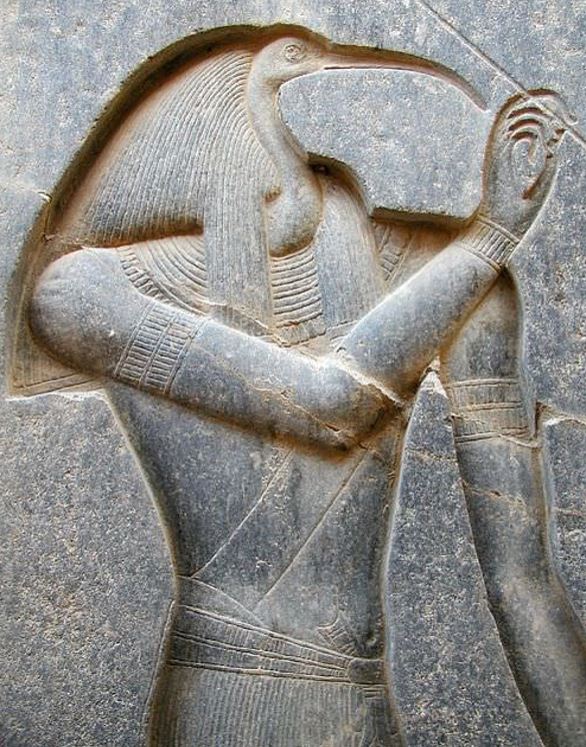
For discussion of Thoth, see Thoth: “the third ends the discord of the two”. ↩ - See note 23. ↩
- The 2nd day of Boedromion. See the passage from Plutarch’s Morals: Quaestiones Convivales above. This is a day that is outside normal time (Eliot’s ‘time, not our time’) and yet is ‘always now’:
And the end and the beginning were always there
Before the beginning and after the end.
And all is always now.
(…)
Quick now, here, now, always—
Ridiculous the waste sad time
Stretching before and after.
(Eliot, Four Quartets, ‘Burnt Norton’) ↩ - Πλούταρχος: ἀλλὰ μάλιστα δεῖ τὴν ἡμέραν ἐκείνην φυλαττομένους, ὡς τοῖς μὲν ἔχθρας ἀνηκέστου καὶ διαφορᾶς τοῖς δὲ φιλίας καὶ ὁμονοίας οὖσαν ἀρχήν. ↩